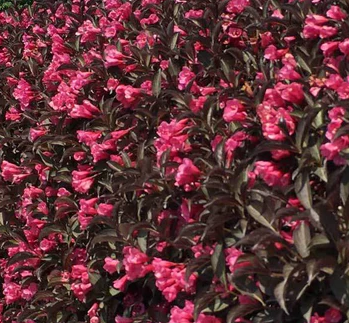Weigela florida Wine & Roses is a beautiful deciduous shrub with narrowly ovate, glossy, dark purple foliage that lasts all season. Large quantities of bright pink flowers bloom throughout the spring and summer, creating an eye-catching contrast. Wine & Roses is the result of Herman Geers’ nearly twenty-year breeding effort in Boskoop, Netherlands. Geers meticulously crossed existing Weigela types, sowing thousands of seeds annually and choosing only those with the darkest leaves. After selecting the best plants, he repeatedly subjected them to cross-pollination until he obtained what he desired, the first true purple-leaved Weigela. This represents a breakthrough in plant development. The combination of vibrant leaves and brilliantly colored, funnel-shaped blooms make Wine & Roses a show-stopping plant from spring to October. Wine & Roses, together with its leaves, creates a lovely cut flower.
Weigela Wine and Roses Height
There are two growing seasons for the Wine and Roses Weigela. In late spring, dazzling pink flowers initially appear. Flowers typically reappear in the summer. The dark wine-colored foliage that accompanies these blooms creates a magnificent focal point regardless of where people decide to put it. This Weigela keeps deer away while attracting hummingbirds.
The wine-colored summer foliage stays that way all season. The blossoms, which appear in the spring as well as the summer, are a vivid and bright pink color. Its spread ranges from 40 to 60 inches, and its garden height is between 48 to 60 inches. It is recommended to use the cut flowers from this Weigela to create colorful bouquets or to enhance the environment. It performs well in mass plantings and as a border plant. The upright growth habit of the Wine and Roses Weigela makes it ideal for use as a container plant.
Proper spacing is essential for healthy roots and plant longevity. It is recommended to leave at least 60 inches of space between Wine and Roses Weigela plants when planting them center on center.
Weigela Wine and Roses Care
The Wine and Roses Weigela requires minimal maintenance. This plant requires a minimum of six hours of sunlight every day and is mostly planted in full sun. It prefers wet, well-drained soil and possesses moderate water requirements. All soil types with different PH levels support this Wine and Roses Weigela. Spring is the ideal time to apply a slow-release fertilizer. Pruning is best done in the spring. Wine & Roses Weigela thrives in a mixture of loam, clay, chalk, and sand that stays moist but drains quickly. This weigela thrives in hardiness zones 4 through 8 and blooms between May and June annually.
Similarly to other types of deciduous shrubs, weigela is mostly transplanted in the fall or early spring. It is best not to move the shrub while it is in bloom or actively sustain its leaf system. Plants that are transplanted during these times often experience shock, leading to growth issues or even death.
Weigela Wine and Roses Pruning
Weigela is a low-maintenance and undemanding plant, requiring just occasional pruning to preserve its shape and promote new growth. This shrub is frequently utilized in the construction of privacy screens, as a foundation planting, and as a focal point.
Weigela needs pruning to keep its shape and fit in place. Weigela is also revitalized through pruning, leading to an increase in both the number and quality of the plant’s magnificent springtime flowers and its imposing green foliage for the remainder of the growing season. It is important to learn how to properly prune Weigela so that the plant continues to develop and reach its full potential. Weigela is best pruned in late spring or early summer after it has completed blooming. Since blooms only appear on new growth that is at least a year old, it is important to wait to prune until the plant attains full bloom to avoid cutting off next year’s crop.
Weigela Wine and Roses Companion Plants
Weigela plants come in several different varieties, each with a distinctive appearance. When selecting a plant to grow with a weigela, keep these qualities in mind. Companion planting with azaleas, such as honeysuckles, is highly recommended for most weigelas. Honeysuckles possess huge, pouting tubular blossoms that compliment the low-lying, thick appearance of weigela plants.
This Weigela Wine and Roses bush contains purple-colored, shiny leaves and pink flowers that bloom all summer long. Weigela Midnight Wine is a popular sub-variety with darker foliage and a purple tint. This particular kind of weigela, which produces a dark and plush background, looks fantastic when paired with Zagreb Coreopsis, which contains yellow blooms. The Variegated Moor Grass is another option because of its striking, cream-colored foliage. Bell Heath, particularly the white type, is also cultivated with similar plants to provide visual contrast.



